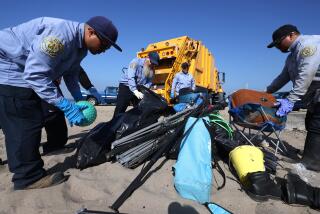Another Try at Beach Restoration
SAN DIEGO — After a decade of false starts, a program is underway to bring sand to sand-starved beaches stretching along San Diego County’s scenic 60-mile coastline.
Sandy beaches are integral to the county’s tourism industry and to local residents’ enjoyment of the Southern California good life.
But many of San Diego County’s beaches have been increasingly stony in recent years.
Mother Nature, so kind to the county in so many ways, has been stingy in providing a natural flow of sand from rivers that empty into the ocean. Upstream development has also hurt.
And what’s worse, the jetty on the county’s northern edge, built to accommodate Camp Pendleton, hampers the southward flow of sand along the coast.
Governmental efforts to provide replacement sand have foundered.
There was the red sand--dirt, to the untutored eye--spread on the beach at Carlsbad that never won public acceptance. There was talk of trucking sand westward from the desert of Imperial County.
The biggest flop came two years ago: a plan by the Navy to spread 6 million cubic yards of sand on local beaches, the result of dredging to accommodate nuclear-powered aircraft carriers in San Diego Bay.
The plan died when bullets and other ornery ordnance began popping up in the dredged-up sand that was being dumped in Oceanside.
The explosives had apparently been dumped overboard years earlier by GIs returning to San Diego. That caused the Navy to change tactics and dump the sand several miles at sea.
But now, after considerable politicking in Sacramento and Washington, a $17.5-million program is underway to put sand on 12 badly eroded beaches from Oceanside to Imperial Beach, starting with Torrey Pines State Beach.
“It’s a miracle,” said Carlsbad Mayor Pro Tem Ann Kulchin, chairwoman of the shoreline preservation committee of the San Diego Assn. of Governments.
The plan calls for 2 million cubic yards of sand dredged from a half-dozen sites about a mile offshore to be pumped to the targeted beaches. Bulldozers will do the spreading.
“Two million cubic yards won’t solve our beach erosion problems, but it’s a start, an investment,” said Steve Sachs, the association’s beach sand expert.
At Torrey Pines State Beach, just north of La Jolla, the replenishment will mean that even at high tide, sun worshipers will find a beach that stretches 150 feet to the water. The rocks that now dot the beach will be buried.
Just how long the sand will remain where it is dumped is unclear.
Officials at Scripps Institution of Oceanography, who are monitoring the project, estimate that within one to five years the sand will have been dispersed along the coastline by waves and tidal patterns.
In the summer, the new sand will be pushed north. In the winter, it will go south. “And on some days, in both directions,” said Scripps researcher Richard Seymour.
Broken Pipe Hinders Project’s Start
Money for the project was cobbled together from beach cities ($1.1 million), the federal government ($9.6 million), and the state ($6.8 million).
Still, the idea of a continuing commitment to keep the rocks at bay is only a dream. New Jersey and Florida, by comparison, consider regional sand replenishment an annual expenditure.
But in San Diego, local governments have been reluctant to pay for sand replenishment.
“We have to educate the inland cities about the importance of the beaches to their economies,” said Oceanside Councilwoman Carol McCauley.
Beach planners opted not to recommend barriers to keep the sand from being washed away. Such barriers often run into opposition from environmentalists.
To keep the Sierra Club in the fold, the dredging will be done at times that do not conflict with the least tern mating season and the annual grunion run.
The 281-foot dredging ship, Sugar Island, will prowl the coast pumping the sand ashore. Each location will take five to 25 days, with pumping around the clock.
The sand replenishment effort got off to a stumbling start.
On Friday, a much-trumpeted news conference was held at Torrey Pines State Beach. But when the long-awaited moment came for the sand to begin spewing onto the beach, all that belched out of the enormous pipe was a few gallons of murky water.
Choppy waves had snapped the pipe connections and the Sugar Island had to move farther out to sea and postpone the dredging.
“We’ve waited all these years,” Kulchin said. “We can wait a little bit longer.”
More to Read
Sign up for Essential California
The most important California stories and recommendations in your inbox every morning.
You may occasionally receive promotional content from the Los Angeles Times.










